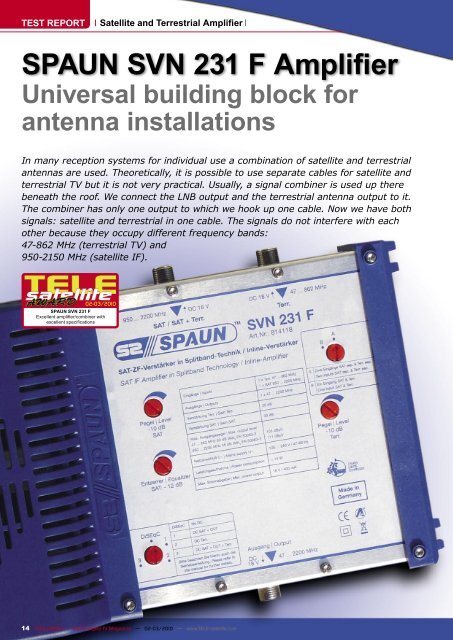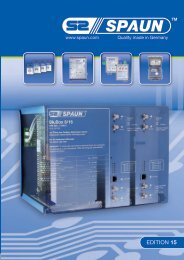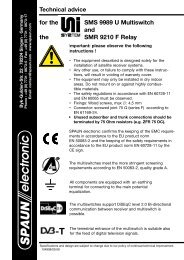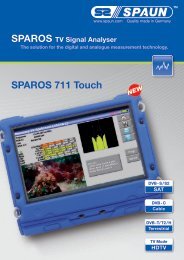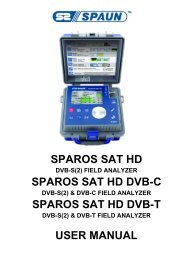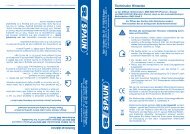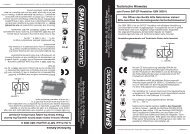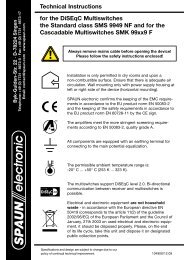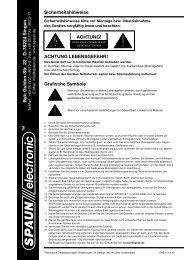SPAUN SVN 231 F Amplifier
SPAUN SVN 231 F Amplifier
SPAUN SVN 231 F Amplifier
You also want an ePaper? Increase the reach of your titles
YUMPU automatically turns print PDFs into web optimized ePapers that Google loves.
TEST REPORT<br />
Satellite and Terrestrial <strong>Amplifier</strong><br />
<strong>SPAUN</strong> <strong>SVN</strong> <strong>231</strong> F <strong>Amplifier</strong><br />
Universal building block for<br />
antenna installations<br />
In many reception systems for individual use a combination of satellite and terrestrial<br />
antennas are used. Theoretically, it is possible to use separate cables for satellite and<br />
terrestrial TV but it is not very practical. Usually, a signal combiner is used up there<br />
beneath the roof. We connect the LNB output and the terrestrial antenna output to it.<br />
The combiner has only one output to which we hook up one cable. Now we have both<br />
signals: satellite and terrestrial in one cable. The signals do not interfere with each<br />
other because they occupy different frequency bands:<br />
47-862 MHz (terrestrial TV) and<br />
950-2150 MHz (satellite IF).<br />
02-03/2010<br />
<strong>SPAUN</strong> <strong>SVN</strong> <strong>231</strong> F<br />
Excellent amplifier/combiner with<br />
excellent specifications<br />
14 TELE-satellite — Global Digital TV Magazine — 02-03/2010 — www.TELE-satellite.com
A simple passive combiner<br />
would add unnecessary and<br />
unwanted signal attenuation.<br />
Therefore, it is much wiser to<br />
use an active device – SAT IF/<br />
Terrestrial TV amplifier. The<br />
well known German manufacturer<br />
of distribution equipment<br />
<strong>SPAUN</strong> Electronic offers<br />
a very interesting product of<br />
this kind. We decided to check<br />
the performance of <strong>SVN</strong> <strong>231</strong> F<br />
<strong>Amplifier</strong>.<br />
<strong>SVN</strong> <strong>231</strong> F provides separate<br />
gain adjustment for satellite<br />
and terrestrial signals.<br />
Satellite signal can be amplified<br />
by 20~30 dB and terrestrial<br />
by 10~20 dB. So, in both<br />
cases, the gain adjustment<br />
range is 10 dB. An interesting<br />
feature is the adjustable<br />
equalizer embedded in the<br />
satellite path. Thanks to it,<br />
you can reduce the gain for<br />
lower frequencies of the IF<br />
we used DC power generated<br />
by <strong>SVN</strong> <strong>231</strong> F to supply active<br />
terrestrial antenna and it<br />
worked perfectly. The switch<br />
was set to position 2. In this<br />
position, 18 V DC (up to 400<br />
mA) was provided on the terrestrial<br />
input and the satellite<br />
input repeated the voltage<br />
and 22 kHz signal present<br />
at the <strong>SVN</strong> <strong>231</strong> F output and<br />
generated by our satellite<br />
receiver.<br />
its output for minimum and<br />
maximum settings of the gain<br />
(level) and slope (equalizer)<br />
controls. We used practically<br />
every satellite transponder,<br />
so the number of the<br />
test frequencies was really<br />
impressive. You can see the<br />
results in the “<strong>Amplifier</strong> gain<br />
vs. frequency” graph.<br />
The actual gain matches<br />
perfectly the specs: 20 dB at<br />
Features<br />
The device is contained in<br />
typical <strong>SPAUN</strong> enclosure with<br />
nice looking blue plastic part<br />
and perfectly finished aluminum<br />
covers. The workmanship,<br />
as always with <strong>SPAUN</strong><br />
distribution equipment, is<br />
excellent.<br />
You can mount <strong>SVN</strong> <strong>231</strong> F<br />
on the wall with 4 screws but<br />
remember that this device<br />
must be placed indoor rather<br />
than in the open air. In most<br />
cases, it will be right below<br />
the roof where the cables<br />
from the satellite and terrestrial<br />
antennas enter the building.<br />
Of course, you will need<br />
the mains supply (100~240V<br />
47~63Hz) to power the amplifier.<br />
Power consumption is<br />
less than 18 W.<br />
band. In this way, you compensate<br />
for the cable losses<br />
which are less for lower frequencies<br />
than for higher frequencies.<br />
According to the<br />
specifications, the adjustment<br />
range is from 0 to -12 dB at<br />
the lower end of IF frequency<br />
range (at 950 MHz).<br />
Additionally, <strong>SVN</strong> <strong>231</strong> F<br />
allows you to power the<br />
devices installed in the terrestrial<br />
input (like antenna<br />
amplifier or active antenna),<br />
satellite input, and even<br />
insert the DC voltage to its<br />
output cable. Using the switch<br />
“DiSEqC-1-2-3” you can select<br />
the option you need in your<br />
installation. In our test circuit<br />
You can use <strong>SVN</strong> <strong>231</strong> F to<br />
amplify and combine satellite<br />
and terrestrial signals and<br />
insert them into one cable but<br />
it can be also used as an inline<br />
amplifier amplifying the<br />
already combined satellite/<br />
terrestrial signal. In such case<br />
you use the satellite input of<br />
<strong>SVN</strong> <strong>231</strong> F and set the switch<br />
A-B to position B.<br />
Performance<br />
Satellite amplifier performance<br />
was the first to be<br />
tested. We used the real<br />
world signal from HOTBIRD<br />
satellite on 13° East and<br />
measured its level at the<br />
input of <strong>SVN</strong> <strong>231</strong> F and at<br />
the level control set to minimum<br />
and 30 dB when the<br />
level control is set to maximum.<br />
The gain is pretty flat<br />
over the entire IF range.<br />
The IF is the signal at the<br />
output of Ku-Band or C-band<br />
LNB. It starts at 950 MHz and<br />
ends at 2150 MHz.<br />
As mentioned before, the<br />
equalizer control allows you<br />
to compensate for the losses<br />
of the cable. According to the<br />
spec it should adjust the gain<br />
at the lowest frequency from 0<br />
to -12 dB. Our measurements<br />
revealed that the adjustment<br />
range is even higher, from 0<br />
to -14 dB.<br />
As a SAT-IF amplifier with<br />
active terrestrial feed, <strong>SVN</strong><br />
<strong>231</strong> F has 2 inputs: one to<br />
connect an LNB, and the other<br />
to connect a terrestrial signal.<br />
Speaking of LNB, this can be<br />
Ku-Band or C-Band LNB – it<br />
does not matter. Both kinds of<br />
LNB’s deliver the output signal<br />
in the frequency range: 950-<br />
2150 MHz. As to the terrestrial<br />
signal, it can be the output of<br />
a single antenna or the output<br />
of several terrestrial antennas<br />
connected together with<br />
branching filters.<br />
www.TELE-satellite.com — 02-03/2010 —<br />
TELE-satellite — Global Digital TV Magazine<br />
15
We are happy to inform you<br />
that practically there was no<br />
change in the signal quality<br />
between the output and the<br />
input. The differences of MER<br />
parameters were for example:<br />
13.0 dB vs. 13.2 dB. This<br />
means that the internal noise<br />
of the <strong>SVN</strong> <strong>231</strong> F is so low that<br />
it does not spoil carrier-tonoise<br />
ratio at all.<br />
After measuring the satellite<br />
signal, we also tried the<br />
terrestrial input. Again we<br />
used the real signal of analog<br />
terrestrial TV. The results are<br />
shown in the “Terrestrial signal<br />
gain” graph. Pretty like with<br />
the satellite signal, also here<br />
the actual gain was almost<br />
exactly equal to the specification:<br />
20 dB for maximum settings<br />
and 10 dB for minimum<br />
settings of the terrestrial level<br />
control.<br />
Finally, we decided to measure<br />
the DVB-T multiplex<br />
available in our location. The<br />
difference of the results versus<br />
the specification was mere 0.2<br />
dB. It is a big pleasure to measure<br />
a device whose actual<br />
performance matches that<br />
closely its specifications!<br />
<strong>SVN</strong> <strong>231</strong> F is an excellent<br />
building block for antenna<br />
installations. It offers high and<br />
adjustable gain both for satellite<br />
and terrestrial signals.<br />
TELE-satellite World<br />
www.TELE-satellite.com/...<br />
Download this report in other languages from the Internet:<br />
Arabic العربية www.TELE-satellite.com/TELE-satellite-1003/ara/spaun.pdf<br />
Indonesian Indonesia www.TELE-satellite.com/TELE-satellite-1003/bid/spaun.pdf<br />
Bulgarian Български www.TELE-satellite.com/TELE-satellite-1003/bul/spaun.pdf<br />
Czech Česky www.TELE-satellite.com/TELE-satellite-1003/ces/spaun.pdf<br />
German Deutsch www.TELE-satellite.com/TELE-satellite-1003/deu/spaun.pdf<br />
English English www.TELE-satellite.com/TELE-satellite-1003/eng/spaun.pdf<br />
Spanish Español www.TELE-satellite.com/TELE-satellite-1003/esp/spaun.pdf<br />
Farsi فارسي www.TELE-satellite.com/TELE-satellite-1003/far/spaun.pdf<br />
French Français www.TELE-satellite.com/TELE-satellite-1003/fra/spaun.pdf<br />
Hebrew עברית www.TELE-satellite.com/TELE-satellite-1003/heb/spaun.pdf<br />
Greek Ελληνικά www.TELE-satellite.com/TELE-satellite-1003/hel/spaun.pdf<br />
Croatian Hrvatski www.TELE-satellite.com/TELE-satellite-1003/hrv/spaun.pdf<br />
Italian Italiano www.TELE-satellite.com/TELE-satellite-1003/ita/spaun.pdf<br />
Hungarian Magyar www.TELE-satellite.com/TELE-satellite-1003/mag/spaun.pdf<br />
Mandarin 中 文 www.TELE-satellite.com/TELE-satellite-1003/man/spaun.pdf<br />
Dutch Nederlands www.TELE-satellite.com/TELE-satellite-1003/ned/spaun.pdf<br />
Polish Polski www.TELE-satellite.com/TELE-satellite-1003/pol/spaun.pdf<br />
Portuguese Português www.TELE-satellite.com/TELE-satellite-1003/por/spaun.pdf<br />
Romanian Românesc www.TELE-satellite.com/TELE-satellite-1003/rom/spaun.pdf<br />
Russian Русский www.TELE-satellite.com/TELE-satellite-1003/rus/spaun.pdf<br />
Swedish Svenska www.TELE-satellite.com/TELE-satellite-1003/sve/spaun.pdf<br />
Turkish Türkçe www.TELE-satellite.com/TELE-satellite-1003/tur/spaun.pdf<br />
Available online starting from 29 January 2010<br />
+<br />
Very flat gain over the entire band<br />
Adjustable gain for satellite and terrestrial signals<br />
Adjustable equalizer for cable losses compensation<br />
Very low internal noise<br />
Actual performance matches or exceeds the specification<br />
Low power consumption<br />
Very good workmanship<br />
Jacek Pawlowski<br />
TELE-satellite<br />
Test Center<br />
Poland<br />
Can be used as an amplifier / signal combiner (SAT + Terr.) as well<br />
as an in-line amplifier<br />
Expert Opinion<br />
-<br />
None<br />
TECHNICAL<br />
DATA<br />
Manufacturer <strong>SPAUN</strong> Electronic, Byk-Gulden-Str. 22,<br />
Internet<br />
E-mail<br />
D-78224 Singen, Germany<br />
www.spaun.com<br />
contact@spaun.com<br />
Phone +49 - 7731 - 8673-0<br />
Fax +49 - 7731 - 8673-17<br />
Model<br />
Function<br />
<strong>SVN</strong> <strong>231</strong> F<br />
SAT-IF/Terrestrial TV amplifier<br />
Inputs Sat: 1 (950…2200 MHz)<br />
Outputs<br />
Gain SAT-IF<br />
Gain Terr.<br />
Level adjustment range<br />
Slope correction range<br />
Mains power supply<br />
Terr.: 1 (47…862 MHz)<br />
1 (47… 2200 MHz)<br />
30 dB<br />
20 dB<br />
0…-10 dB<br />
0…-12 dB<br />
Power consumption


